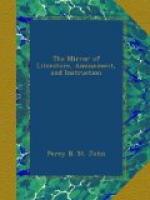The time of Aszer (or about three o’clock, P.M.) approached, when that ceremony of the Hadj takes place, for which the whole assembly had come hither. The pilgrims now pressed forward towards the mountain of Arafat, and covered its sides from top to bottom. At the precise time of Aszer, the preacher took his stand upon the platform on the mountain, and began to address the multitude. This sermon, which lasts till sun-set, constitutes the holy ceremony of the Hadj called Khotbet el Wakfe; and no pilgrim, although he may have visited all the holy places of Mekka, is entitled to the name of hadjy, unless he has been present on this occasion. As Aszer approached, therefore, all the tents were struck, every thing was packed up, the caravans began to load, and the pilgrims belonging to them mounted their camels, and crowded round the mountain, to be within sight of the preacher, which is sufficient, as the greater part of the multitude is necessarily too distant to hear him. The two pashas, with their whole cavalry drawn up in two squadrons behind them, took their post in the rear of the deep lines of camels of the hadjys, to which those of the people of the Hedjaz were also joined; and here they waited in solemn and respectful silence the conclusion of the sermon. Further removed from the preacher, was the Sherif Yahya, with his small body of soldiers, distinguished by several green standards carried before him. The two Mahmals, or holy camels, which carry on their back the high structure that serves as the banner of their respective caravans, made way with difficulty through the ranks of camels that encircled the southern and eastern sides of the hill, opposite to the preacher, and took their station, surrounded by their guards, directly under the platform in front of him.[6]
The preacher, or Khatyb, who is usually the Kadhy of Mekka, was mounted upon a finely caparisoned camel, which had been led up the steps; it being traditionally said that Mohammed was always seated when he here addressed his followers, a practice in which he was imitated by all the Khalifes who came to the Hadj, and who from hence addressed their subjects in person. The Turkish gentleman of Constantinople, however, unused to camel-riding, could not keep his seat so well as the hardy Bedouin prophet; and the camel becoming unruly, he was soon obliged to alight from it. He read his sermon from a book in Arabic, which he held in his hands. At intervals of every four or five minutes he paused, and stretched forth his arms to implore blessings from above; while the assembled multitudes around and before him waved the skirts of their ihrams over their heads, and rent the air with shouts of “Lebeyk, Allahuma Lebeyk,” (i.e. Here we are, at thy commands, O God!) During the wavings of the ihrams, the side of the mountain, thickly crowded as it was by the people in their white garments, had the appearance of a cataract of water; while the green umbrellas, with which several thousand hadjys, sitting on their camels below, were provided, bore some resemblance to a verdant plain.—During his sermon, which lasted almost three hours, the Kadhy was seen constantly to wipe his eyes with a handkerchief; for the law enjoins the Khatyb or preacher to be moved with feeling and compunction; and adds that, whenever tears appear on his face, it is a sign that the Almighty enlightens him, and is ready to listen to his prayers.




